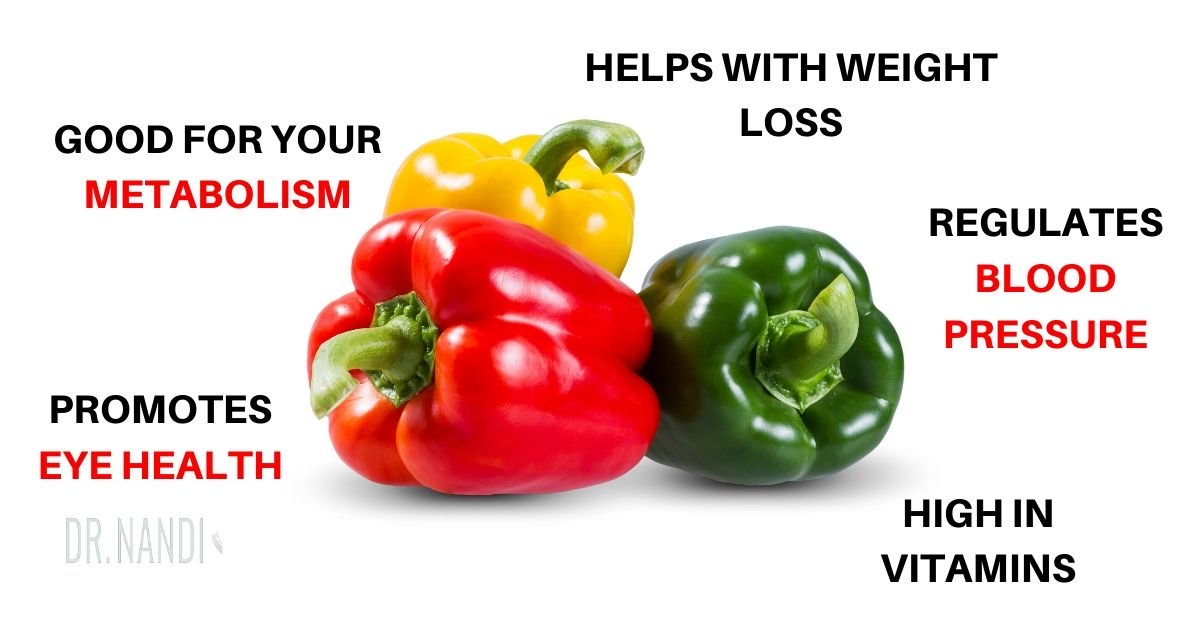Sweet Peppers, also known as bell peppers, are most commonly colored green, yellow, orange, and red. They may also be colored white, lavender, purple, or brown depending on the variety. Sweet peppers range in taste from the more bitter green pepper to the sweet red peppers. First introduced to Europe in 1493, peppers are native to Central America, Mexico, Northern America, and South America. Sweet peppers are grown worldwide, with China being the biggest grower. What may be surprising is that, aside from water (92% of the pepper), the rest of the pepper comprises carbs, protein, and fat.
Some people may see these compounds and think they make peppers unhealthy, but they are considered healthy food. They are very versatile and can go into various dishes, be used with dips, or be eaten plain.
11 Healthy Benefits of Eating Sweet Bell Peppers
Sweet Peppers are Nutrient-Dense
Green bell peppers are a rich source of vitamins and minerals. They’re also high in fiber and contain a few carbohydrates. Green peppers, like all other vegetables, include smaller amounts of other vitamins and minerals, including thiamine (B1), magnesium, copper, and vitamin E.
Vitamin C is abundant in sweet green peppers. Vitamin C is water-soluble, so your body can’t store it well. As a result, you must consume it regularly to keep your body healthy. Vitamin C is essential for many critical bodily functions, including good immune function, collagen synthesis, and nutrient metabolism. (1, 2)
Vitamin B6 is also present in the peppers, which is required for nutrient metabolism, immune function, and neurotransmitter synthesis (producing chemical messengers). It also aids in forming hemoglobin, a protein that transports oxygen throughout red blood cells. (3)
Green sweet peppers are also a great source of vitamin A, which your body can transform into vitamin A. Provitamin A is present in the form of beta carotene, a plant compound with bright colors and numerous health advantages. Furthermore, sweet green peppers are low in calories and relatively low in carbohydrates. They’re also high in fiber.
Sweet Peppers are Good for Your Metabolism
Studies show that sweet red pepper is excellent for increasing your metabolism. Studies are being conducted about the activation of thermogenesis and an increased metabolic rate. Even though red sweet peppers don’t contain capsaicin, which is known to make peppers hot, they have a mild thermogenic action. It has been studied and known to increase our metabolism without increasing our heart rate, and blood pressure like hot peppers do, making it a better choice for individuals with heart problems.
Also Read: 12 ways of boosting metabolism
Sweet Peppers Promote Eye Health
The sweet pepper contains over 30 carotenoid types, including alpha-carotene, lutein, zeaxanthin, and lycopene. The carotenoids are a phytonutrient family that is the reason for the red, yellow, and orange coloring found in many fruits and vegetables. These carotenoids have been found to help heal eyes and to help fight eye diseases and improve eye health. Research conducted with sweet peppers has found that the carotenoids absorb the damaging blue light as it enters the eyes and stops the damage.
Sweet Peppers are Good for the Heart
Adding more fruits and vegetables to your diet, such as green sweet peppers, is a good way to promote heart health. Studies have linked diets high in fruit and vegetables with a decreased risk of heart disease. Eating more fruit and vegetables, for example, can reduce cholesterol levels and blood sugar levels, as well as blood pressure. (4, 5, 6, 7)
Sweet Peppers are Good for Gut Health
Peppers are high in fiber, which is beneficial for gut health. Men should consume 1.1–1.2 ounces (30–35 grams) of fiber daily, while women should eat 0.9–1.1 ounces (25–32 grams). (8)
A single cup (150 grams) of raw green pepper contains 0.08 ounces (2.5 grams) of fiber. Increasing your fiber intake has been shown in studies to help prevent digestive system diseases like digestive enzymes, including colon cancer and inflammatory bowel disease (IBD). (9)
Fiber-rich meals can also assist your digestive system in functioning correctly by preventing constipation and maintaining a healthy gut bacteria balance. For an extra fiber boost, try munching on sliced green bell pepper with hummus or tossing chopped green bell pepper into salads, chili, and stir-fries.
Sweet Peppers Contain Health-Benefiting Plant Compounds
Plant chemicals found in peppers include antioxidants and anti-inflammatories. For example, this vegetable contains flavonoids, vitamin C, phenolic compounds, and carotenoids, all of which have health benefits. (10)
According to a 2019 research examining the bioactive component levels in sweet peppers, sweet green peppers had greater phenolic acids, especially p-coumaric acid, than red, orange, and yellow peppers. Diets high in phenolic acids have been found to protect against diabetes, fatty liver, cognitive impairment, and heart disease. (11, 12, 13)
Furthermore, in 2013 research, green bell pepper extract showed more excellent antioxidant activity than red, orange, and yellow bell pepper extracts. (14)
Sweet Peppers Help With Weight Loss
Nutritionists suggest adding sweet peppers to your diet to help you lose weight or maintain a healthy weight. One serving of sweet peppers has roughly 1 gram of fat and only 29 calories. Nutritionists suggest adding sweet peppers as a snack or an addition to your main meal. The small amount of fat in the peppers provides reliable storage for sweet pepper’s fat-soluble nutrients.
Sweet Peppers Regulate Blood Pressure
If you want to add more potassium to your diet, reach for sweet peppers. All colors of the peppers are a great source of potassium. Potassium is needed to maintain a proper balance of the fluids and minerals in your body. Plus, research shows that potassium enhances muscle function and regulates blood pressure. One cup of sweet peppers adds 260 to more than 300 mg of potassium to your diet. As a bonus, sweet peppers contain fiber, which can help regulate heart health by controlling cholesterol levels.
Sweet Peppers are High in Vitamins
You can get a lot of vitamin A from sweet peppers, which is essential for your eyes to stay healthy. One cup of red sweet peppers has almost all of the vitamin A you need for a whole day, so they’re good for you. Sweet pepper has a lot of vitamin C, which helps keep tissues healthy and boosts your immune system. One cup of sweet peppers provides over 100% of the daily allowance of vitamin C. Pregnant women or women who hope to become pregnant should also add sweet peppers to their diet. Peppers have folate, which aids in supporting the function of red blood cells and helps prevent certain types of congenital disabilities in unborn children. Studies are being done regarding folate and the prevention of colorectal cancer. Sweet peppers are also a source of vitamin K, which is necessary for the clotting function of blood.
Sweet Peppers May Reduce the Likelihood of Anemia
Anemia is a disease that occurs when there isn’t enough oxygen in the blood. Low iron levels are one of the most typical causes. Bell peppers have only a modest amount of iron but are high in vitamin C, with half a pepper providing as much as 100mg. It is significant because vitamin C aids in iron absorption in the gut. Several studies have shown that diets high in vitamin C-rich fruits and vegetables enhance iron uptake because they include vitamin B6; bell peppers aid further since it is required to form hemoglobin, the protein that transports oxygen throughout the body.
Sweet Peppers May Protect Against Certain Chronic Diseases
Bell peppers are high in antioxidants and linked to a decreased risk of heart disease and cancer. Peppers are incredibly high in antioxidant vitamins such as vitamin C, E, and beta-carotene. The red-hued fruit is also high in polyphenols, which offer several health advantages. Lutein, quercetin, and capsanthin are some of the protective plant chemicals in abundance; the latter is particularly rich in ripe red peppers. Peppers’ capacity to reduce inflammation makes them an excellent anti-inflammatory food option. Unfortunately, no large-scale research has examined the relationship between bell pepper consumption and chronic illness.
Though most people tolerate bell peppers quite well, people may be allergic to them in rare cases. Someone with a very sensitive pollen allergy may also be allergic to bell peppers due to cross-contamination.
Are Green Bell Peppers Just Unripe Red Bell Peppers?
Yes, some of them. However, unripe Orange or Yellow Bell Peppers might be among them! A Green Bell Pepper is a bell pepper that has been picked prematurely. It implies there are no Green Bell Pepper subvarieties!
Green Bell Peppers are picked before they can develop sweetness; consequently, they do not obtain all of the natural sugars that a Pepper would get during the ripening process. Green Bell Peppers have a significantly harsher flavor than Red, Orange, or Yellow Bell Peppers – they have been harvested before they could begin to sweeten.
Which Color of Bell Pepper Is the Healthiest?
The health advantages of Red, Orange, and Yellow Bell Peppers are all similar. They all have comparable amounts of vitamins A and C, regardless of their distinct hues. Lycopene is also present in Red Bell Peppers, an antioxidant that helps fight oxidative stress in the body. The carotenoids found in Yellow and Orange Bell Peppers also have antioxidant effects.
Another thing to remember is that all three colors of Bell Peppers we raise have significantly more nutritional content than Green Bell Peppers, which are picked before the ripening process is finished. All of the nutrients and natural sugars are absorbed by the pepper.
Discover different ways how you can include bell peppers in your daily diet. Get a FREE copy of my Superfood Cookbook.
References:
- Vitamin C – Health Professional Fact Sheet (nih.gov)
- Frontiers | The Long History of Vitamin C: From Prevention of the Common Cold to Potential Aid in the Treatment of COVID-19 | Immunology (frontiersin.org)
- Vitamin B6 – Health Professional Fact Sheet (nih.gov)
- Fruit and vegetable intake and the risk of cardiovascular disease, total cancer and all-cause mortality—a systematic review and dose-response meta-analysis of prospective studies – PMC (nih.gov)
- Fruit, vegetable, and legume intake, and cardiovascular disease and deaths in 18 countries (PURE): a prospective cohort study – The Lancet
- Fruit and vegetable intake and cardiovascular risk factors in people with newly diagnosed type 2 diabetes – PMC (nih.gov)
- Fruits for Prevention and Treatment of Cardiovascular Diseases – PMC (nih.gov)
- The Health Benefits of Dietary Fibre – PMC (nih.gov)
- FoodData Central (usda.gov)
- Capsaicinoids, Polyphenols and Antioxidant Activities of Capsicum annuum: Comparative Study of the Effect of Ripening Stage and Cooking Methods – PMC (nih.gov)
- Bioactive Compounds, Antioxidant Activity and Inhibition of Key Enzymes Relevant to Alzheimer’s Disease from Sweet Pepper (Capsicum annuum) Extracts – PMC (nih.gov)
- Higher phenolic acid intake independently associates with lower prevalence of insulin resistance and non-alcoholic fatty liver disease – PMC (nih.gov)
- Dietary Phenolic Acids and Their Major Food Sources Are Associated with Cognitive Status in Older Italian Adults – PMC (nih.gov)
- Implication of dietary phenolic acids on inflammation in cardiovascular disease – PubMed (nih.gov)



















